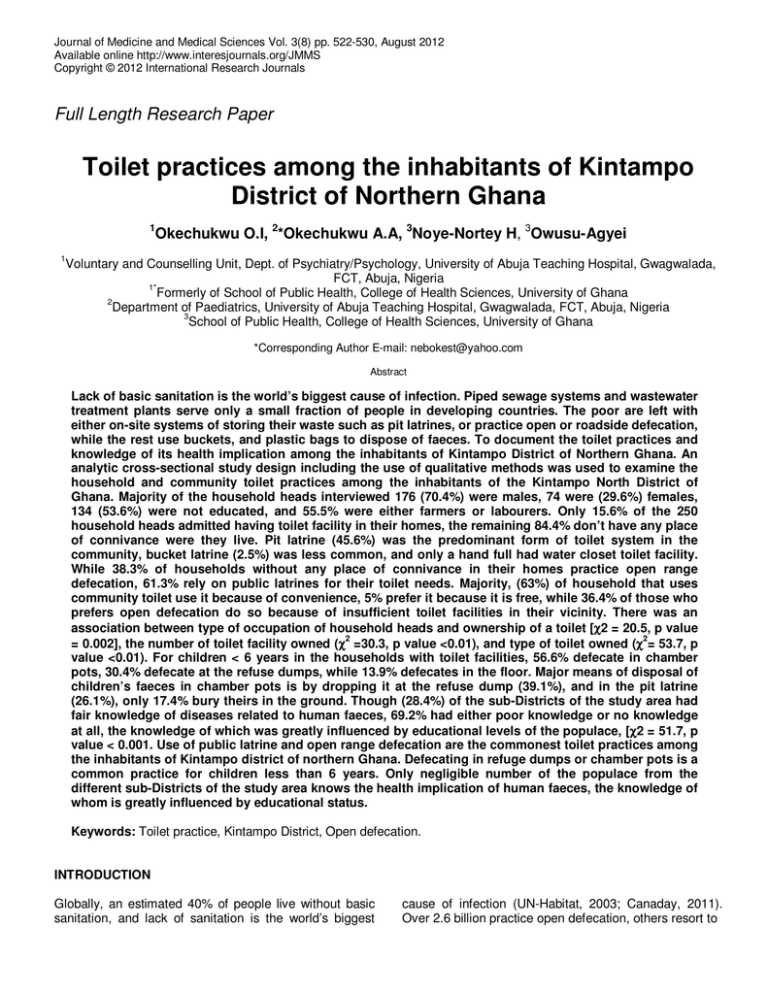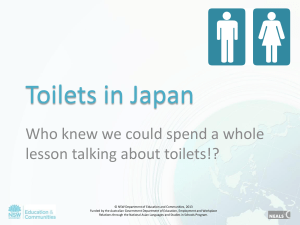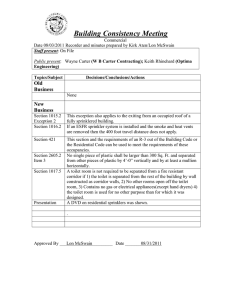Document 14240097
advertisement

Journal of Medicine and Medical Sciences Vol. 3(8) pp. 522-530, August 2012 Available online http://www.interesjournals.org/JMMS Copyright © 2012 International Research Journals Full Length Research Paper Toilet practices among the inhabitants of Kintampo District of Northern Ghana 1 Okechukwu O.I, 2*Okechukwu A.A, 3Noye-Nortey H, 3Owusu-Agyei 1 Voluntary and Counselling Unit, Dept. of Psychiatry/Psychology, University of Abuja Teaching Hospital, Gwagwalada, FCT, Abuja, Nigeria 1* Formerly of School of Public Health, College of Health Sciences, University of Ghana 2 Department of Paediatrics, University of Abuja Teaching Hospital, Gwagwalada, FCT, Abuja, Nigeria 3 School of Public Health, College of Health Sciences, University of Ghana *Corresponding Author E-mail: nebokest@yahoo.com Abstract Lack of basic sanitation is the world’s biggest cause of infection. Piped sewage systems and wastewater treatment plants serve only a small fraction of people in developing countries. The poor are left with either on-site systems of storing their waste such as pit latrines, or practice open or roadside defecation, while the rest use buckets, and plastic bags to dispose of faeces. To document the toilet practices and knowledge of its health implication among the inhabitants of Kintampo District of Northern Ghana. An analytic cross-sectional study design including the use of qualitative methods was used to examine the household and community toilet practices among the inhabitants of the Kintampo North District of Ghana. Majority of the household heads interviewed 176 (70.4%) were males, 74 were (29.6%) females, 134 (53.6%) were not educated, and 55.5% were either farmers or labourers. Only 15.6% of the 250 household heads admitted having toilet facility in their homes, the remaining 84.4% don’t have any place of connivance were they live. Pit latrine (45.6%) was the predominant form of toilet system in the community, bucket latrine (2.5%) was less common, and only a hand full had water closet toilet facility. While 38.3% of households without any place of connivance in their homes practice open range defecation, 61.3% rely on public latrines for their toilet needs. Majority, (63%) of household that uses community toilet use it because of convenience, 5% prefer it because it is free, while 36.4% of those who prefers open defecation do so because of insufficient toilet facilities in their vicinity. There was an association between type of occupation of household heads and ownership of a toilet [χ χ2 = 20.5, p value 2 2 = 0.002], the number of toilet facility owned (χ χ =30.3, p value <0.01), and type of toilet owned (χ χ = 53.7, p value <0.01). For children < 6 years in the households with toilet facilities, 56.6% defecate in chamber pots, 30.4% defecate at the refuse dumps, while 13.9% defecates in the floor. Major means of disposal of children’s faeces in chamber pots is by dropping it at the refuse dump (39.1%), and in the pit latrine (26.1%), only 17.4% bury theirs in the ground. Though (28.4%) of the sub-Districts of the study area had fair knowledge of diseases related to human faeces, 69.2% had either poor knowledge or no knowledge at all, the knowledge of which was greatly influenced by educational levels of the populace, [χ χ2 = 51.7, p value < 0.001. Use of public latrine and open range defecation are the commonest toilet practices among the inhabitants of Kintampo district of northern Ghana. Defecating in refuge dumps or chamber pots is a common practice for children less than 6 years. Only negligible number of the populace from the different sub-Districts of the study area knows the health implication of human faeces, the knowledge of whom is greatly influenced by educational status. Keywords: Toilet practice, Kintampo District, Open defecation. INTRODUCTION Globally, an estimated 40% of people live without basic sanitation, and lack of sanitation is the world’s biggest cause of infection (UN-Habitat, 2003; Canaday, 2011). Over 2.6 billion practice open defecation, others resort to Okechukwu et al. 523 use of buckets/ plastic bags to dispose of faeces, while many either urinate in open places or into the rivers (Bill and Melinda Gates Foundation, 2011). All these practices constitute one of the biggest threats to human health, and remain the major cause of waterborne diseases such as acute diarrhea, cholera, dysentery, hepatitis, typhoid, and intestinal worms (Bill and Melinda Gates Foundation, 2011; Conant and Fadem, 2008). The most vulnerable are the people living in large agglomerations under unsanitary conditions in developing world. In these areas, most waste water goes straight into the environment without treatment, and many people do not have access to the piped water needed to make such wastewater, thus the fecal contamination of their environment is even more direct (UN-Habitat, 2003; Canaday 2011). In 2001, the World Toilet Organization declared November 19 as World Toilet Day to raise global awareness of the struggle 2.6 billion people faces every day without access to proper/ clean sanitation, and the health, emotional, psychological consequences the poor endure as a result of inadequate sanitation (Bill and Melinda Gates Foundation, 2011). Conventional sanitation; a flush toilet connected to a centralized sewer system is possible for only a small fraction of people in developing nations, thus the poor are left with on-site systems of faeces disposal such as pit or bucket latrines (Bill and Melinda Gates Foundation, 2011; Wittington et al., 1993; Arku et al., 2008). In such situations, waste does not decompose fast enough or completely, so the pits or bucket toilets fill up fast, leading to flies, odors, and unpleasant conditions (Wittington et al., 1993; Arku et al., 2008). Because replacing or emptying full pits latrine is difficult and expensive, many people resort to defecating outdoors, which poses not only a serious health risks but a practice that is socially demeaning (Wittington et al., 1993; Arku et al., 2008). The need to make sanitation accessible to the poor is clear; the consequences of unsafe sanitation can be devastating and can last for a lifetime. Eighty eight percent (88%) of the world diarrhea cases are attributable to unsafe water, inadequate sanitation or insufficient hygiene (Bill and Melinda Gates Foundation, 2011; WHO and UNICEF, 2004). Almost one-tenth of the global disease burden could be prevented by improving water supply, basic sanitation, and hygienic practices (Canaday, 2011; Bill and Melinda Gates Foundation, 2011; WHO and UNICEF, 2004). Such improvement will no doubt reduce child mortality and improve health and nutritional status of many children around the world whom fecao-oral contamination is responsible for more than 50 percent of deaths yearly in the developing world. Food and water tainted with fecal matter cause up to 2.5 billion cases of acute diarrhea among children, resulting in 1.5 million deaths (Bill and Melinda Gates Foundation, 2011;WHO and UNICEF, 2004; UNICEF/WHO 2008). And official statistics by the Ghana Health Service indicates that about 80% of all outpatients attendance are cases of sanitation and water related diseases (UNICEF/WHO, 2008; Ghanaian Daily Graphic, 2009). The impact clean and safe sanitation can deliver is also potentially transformational. People who have access to clean, safe, and convenient sanitation services experience greater dignity, privacy, and security (Bill and Melinda Gates Foundation, 2011). This is especially important for women and girls, who will not risk sexual assault when they have to defecate in the open or use public facilities (Bill and Melinda Gates Foundation, 2011). Public toilets have become an important feature in Ghanaian urban life (Frantzen and Post, 2001; Arku, 2010; Amuzu and Leitmann, 1994; Ayee and Crook 2003; King et al, 2001; Davis, 1986; Devas and Korboe, 2000). They are the main facility for people in low income, densely populated or informal settlement areas, they also serve the interest of public health (Arku et al., 2008). Without them, people in low income densely populated areas will be compelled to defecate in the “bush or beach”, which is likely to aggravate environmental health hazards in a country that is already prone to diseases such as malaria, diarrhoea, dysentery, cholera and bilharzias (Amuzu and Leitmann, 1994; Ayee and Crook 2003; King et al, 2001). The history of public toilets in Ghana can be traced back to the colonial period (Ayee and Crook 2003; King et al, 2001; Davis, 1986; Devas and Korboe, 2000; Devas et al.,2001). Before colonial rule, residents in Ghanaian towns used pit-latrines located at the outskirts of the community to minimize stench and prevent flies, which they considered an environmental hazards. However, as a result of population growth with its attendant public health hazards, the use of pit latrines became obsolete. Consequently, “bucket latrine” system with “night soil” collection, became dominant (Ayee and Crook 2003). In line with their sanitation policies, the government of that era constructed public toilets in the early 1930s in Accra and Kumasi. The number of public toilets increased during the post-colonial period not only because of policies pursued by successive governments but also the practical problem of dealing with rising population (Arku, 2010; Ayee and Crook 2003). Ghana is currently off-track in terms of achieving the Millennium Development Goals (MDGs) for access to improved toilet facilities (WHO and UNICEF, 2004). According to the most recent report of the Joint Monitoring Programme of WHO and UNICEF on the progress of water and sanitation in Ghana, only about 2.2 million people in Ghana have access to decent household toilets, more than eleven million (51%) use shared or public facilities, and open defecation reduced marginally from 24% in 1990 to 20% in 2006 (WHO and UNICEF, 2004). The present study was undertaken to documents the present day toilet practices among the inhabitants of Kintampo District of Northern Ghana. It also assessed the knowledge and health implications of their toilet practices. The result is envisaged to assist the 524 J. Med. Med. Sci. policy maker in prioritizing the sanitation need of their community. MATERIALS AND METHODS The study was a descriptive study utilizing both quantitative and qualitative methods for data collection. A detailed structured questionnaire was used to collect information on household socio-demographic characteristics from household heads. The type of toilet and toilet practices of the households were assessed including those of children within the households. The Focus group discussions (FGD) using semi-structured questionnaires were used to assess communities’ toilet practices and its health implication. The In-depth Interviews were also used to collect information on individual views on different toilet practices and its illeffect on health in the district (see JMMS, 2012; Vol. 3(3) pp. 146-154). The Kintampo North District is one of the 19 districts of the Brong Ahafo region of Ghana. For administrative convenience, the district was demarcated into 7 subdistricts. Kintampo sub district is located at the centre of Ghana, and a major transit point for many travelers, tourist and traders. The main indigenous ethnic groups are the Akans, Bonos and the Mos, while the major economic activity is small scale farming and trading. It has a district hospital, three clinics, four health centers, a maternity home, a rural health training school, and a research centre. Using the projected population size for household heads in 2006 in the Kintampo North District is 3155, a sample size of 235 was calculated at 95% confidence interval, but a sample size of 250 was used to make room for incomplete questionnaires and improve precision of the study. The sample size of 250 was distributed among the communities in the 7 sub-district according by simple random sampling method. The method ensured that each participant was chosen completely at random without introducing any form of bias. A household is defined as all the people living together in a house. 19 For the purpose of the study theoretical training was conducted for the data collectors. Household heads were interviewed to get information on the type and toilet practices of people in their household. Eleven FGDs consisting of twelve participants in each session and moderated by two research personnel were conducted in Twi language (a common language spoken in Ghana) and latter translated to English in addition to the quantitative data to buttress the findings of the study. The FGDs were used to assess communities’ knowledge, practices and perception of their toilet practices and their health perception in the district. Each discussion session lasted for about an hour and was recorded in a tape with the permission of the participants. The tapes were then transcribed and translated from Twi to English for a clear understanding of its contents. Coding of the transcript was done manually to identify consistent themes during the discussions. Those items that came up the most were considered the groups’ main opinion. Data analysis was conducted using SPSS 12.O. The study was undertaken under the approval of the Ghana Health Service National Ethical Committee as well as the Kintampo Health Research Centre Ethical Committee. A written informed consent was obtained from the participants who were willing to take part in the study. No one was forced to take part in the study. RESULTS The socio-demographic and household characteristics of the household heads involved in the survey are presented in Table 1. Those used in the FGDs had similar characteristics. The main economic activity of most of the participants in the study was farming/labourers (55.2%), and trading (18.4%). Sex distribution indicates more male (70.4%) than female (29.6%) with 29.6% being above 60 years, majority 78.0% were married, 53.6% had no education, and 62.8% came from Kintampo sub district of the study area, while Akans form 22.0% of the ethnic groups. Table 2 shows the toilet facilities in the household and toilet practices of children < 6 years. While 45.2% of the household studied has 5-10 persons per household, majority (84.4%) don’t have toilet facilities in their homes. Reason(s) given being high cost of building a toilet and emptying it when full, the general believe that a person cannot stay in the same house where there is toilet facility because of the odour, and the fact that the study area has a vast area of land were one can easily free him or herself in the bush. For the children < 6 years in the households with toilet facilities, 56.6% defecate in chamber pots, 30.4% defecate at the refuse dumps, while 13.9% defecates in the floor. Means for disposal of children’s faeces in chamber pots is by dropping it at the refuse dump (39.1%), in the pit latrine (26.1%), while 17.4% bury them in the ground. From FGDs, a discussant had this to say, “My children cannot use the community toilets so the older ones use the refuse dump to defecate, while the younger ones use the chamber pots and I throw the faeces at the refuse dump”. Figure 1 shows nature of toilet facilities in households with toilets. Majority of the households with toilet have a pit latrine 17(45.6%), 12 (30.8%) have KVIP (Kumasi ventilated improved pits) toilet facilities, 9(23.1%) have water closet type, while 1(2.5%) had bucket latrine. The discussants from the FGDs also said that the major kinds of toilets they have are the KVIP and the Pit latrine. KVIP is a double vault composting toilet used for public toilets in Ghana. Only one female discussant mentioned owing a WC (water closet) in her house. Figure 2 shows places where households without Okechukwu et al. 525 Table 1. Socio-Demographic Characteristics of Household Heads (N = 250) Characteristics Sex Male Female Educational level None Primary school Middle/Contn. Sch, Jss Tech/Comm./SSS School Post Secondary University Occupation Professional Clerical/Secretarial Seamstress, hair dresser etc Trader/ Food seller Labourer/ Farmer None Other** Sub-District Busuama (1) Dawadawa (2) Gulumpe (3) Kadelso (4) Kintampo (5) Kunsu (6) New Longoro (7) Frequency Percentage 176 74 70.4 29.6 134 21 63 19 10 3 53.6 8.4 25.2 7.6 4.0 1.2 17 12 9 46 138 17 11 6.8 4.8 3.6 18.4 55.2 4.4 6.8 10.4 6.4 10.8 4.0 62.8 2.0 3.6 ** Driver, Pensioner, Blacksmith toilets defecate. Most 129 (61.3%) of the homes without toilet facility use community toilets, 81 (38.4%) practice open defecation, while negligible number (< 1%) use their neighbour’s toilet. Similar response was also obtained from the discussants in Focus Group as exemplified by the following statements from female discussants: “I use the community toilet to defecate as we don’t have a toilet in our house”, another said “because the community toilets were so dirty and the hot air coming from it smells so badly, I prefer to go to my farm to defecate.” Household heads without toilet prefer community toilets because it is more convenient (54.9%), it is cleaner (14.2%), well ventilated (9.4%), and not costly (5.0%), [data not shown]. This is in contrast to the information from the FGDs where majority of the discussants claim they don’t use community toilets because of cost. For households heads that prefer open defecation, (36.0%) prefer it because of insufficient toilet facilities in the community, 22.7% said it is more convenience, while 4.5% said because available toilet is too far. These reasons also differ from what was obtained from FGDs where most of the discussants preferred open range defecation due to the sordid conditions of the community toilets. Tables 3 and 4 shows association between occupation and type of toilet owned by the household heads, and comparison of knowledge of diseases related to human faeces across sub-districts. There is an association between type of occupation of household heads and ownership of a toilet [χ2 = 20.5, p value = 0.002], the 2 number of toilet facility owned (χ =30.3, p value <0.01), 2 and type of toilet (χ = 53.7, p value <0.01). In table 4, while Gulumpe (3.7%) and Kintampo sub District of the study area had good knowledge of diseases associated with human faeces, other sub Districts don’t have good knowledge. 28.4% had fair knowledge, 38.0% had poor knowledge, while 31.2% had no knowledge at all. Cholera (74.1%) was mentioned as the most common diseases related to human faeces, malaria was ranked second (36.3%), diarrhoea (32.4%) the third, while typhoid (20.6%), and dysentery (8.3%) were the fourth and the fifth in rank. 19.1% mentioned other diseases such as pile, body odour, HIV, hook worm, ring worm, vomiting, and hernia in relation to human faeces (data not shown). FGDs also showed similar findings. A statistical test showed significant association between the knowledge of the diseases associated with faeces and the sub districts of the study area (χ2 = 526 J. Med. Med. Sci. Table 2. Toilet Facilities In The Household And Toilet Practices of Children < 6 Years Characteristics No. of people in the household 1-4 5-10 11-15 Above 15 No. of household with toilets Yes No No. of toilets in the household One Two Can children under 6 use the toilets? (n=39) Yes No If No, Where do they defecate(n = 23) On the floor Refuse dump Chamber pots How do you dispose it off? (n = 23) Burning Open disposal Dumpsite flushing Others (Burning) For households with toilets (n=39), who cleans it? Adults Youth Child No-one Do they disinfect their toilet? Yes No How many times do they disinfect their toilets in a week Daily Twice a week or more Once a week 47.489, p value <0.01). Household heads knowledge of diseases and human faeces shows good knowledge for Typhoid + Diarrhoea/Dysentery + Cholera – Malaria and fair knowledge for Typhoid + Diarrhea/Dysentery + Cholera +Malaria. DISCUSSION It was very obvious from the result of the present study that majority of the respondents (84.4%) in Kintampo North district of Ghana do not have toilet facility in their Frequency Percentages 105 113 16 16 42.0 45.2 6.4 6.4 39 211 15.6 84.4 35 4 89.7 10.3 16 23 41.0 59.0 3 7 13 13.0 30.4 56.6 2 2 9 6 4 8.7 8.7 39.1 26.1 17.4 33 5 1 0 84.6 12.8 2.6 0 31 8 79.5 20.5 8 10 13 25.8 32.3 41.9 various homes. Similar findings was also reported by the Ghanaian Daily Graphic (70.0%) (Frantzen and Post 2001) and rural India (75.0%) (Saleth and Sastry 2004), and points to the fact that a lot has to be done in terms of provision toilet facilities to people living in rural, semi urban, and urban Ghettos. Most respondents from the study area relied on community latrines (61.3%) and open range defecation (38.4%) for their toilet needs. The few (15.6%) with toilet facilities in their homes were mainly pit latrines, only a handful had flush latrines. Similar research carried out in northern Nigeria showed comparable results where 20.9% of households practiced Okechukwu et al. 527 Number of Households Figure 1. Nature of toilet facility in households with toilets 18 16 14 12 10 8 6 4 2 0 W/C KVIP Pit latrine Bucket latrine Kind of Toilet W/C: Water closet KVIP: Kumasi Ventilated Improved Pits Figure 2. Places where households without toilet defecates <1% 38.4% 61.3% o pen d efe ction c omm unity pit to ilet/KVIP An other h ous ehold toilet open range defecation, and 70.1% of those with toilet facilities use pit latrines (Ebong, 1994). The reported 84% preference for open defecation by Arku et al., 2008 from another rural setting in Ghana showed a wide discrepancy from the result of the present, and reiterated the fact that money plays a vital role in determining the household owning a toilet or the type of toilet facility in the household. This was seen in this study where association exists between the type of occupation of household heads and ownership of a toilet (χ2 = 20.459, 6df, p = .002), the number of toilets owned (χ2 =30.3, p value <0.01) and type of toilet facilities in various homes 2 (χ = 53.7, p value <0.01), and were majority of the household heads were either subsistent farmers (55.2%) or petty traders (18.4%). Other studies have found similar association in access to sanitary toilet facility among different social classes (Boadi and Kuitunen, 2005). Provision of more toilet facilities in various homes or community level should be a high priority in the district to combat the problem of open range defecation. Latrine marketing aimed at educating the people on the advantages of owning latrine should be introduced (Obika et al., 2002). Successful marketing is based on understanding of what people want and are willing to use/ maintain and on which sanitation technologies are locally appropriate (Cairncross, 2004). Awareness and understanding of the different latrine technology choices should be provided to aid in making choices that favour the community financially (Jenkins, 1994). There is also the need to target an open defecation free environment and not just a landscape of toilets. Though outdoor defecation is common in the study community, only 22 (5%) of the household heads indicate preference for open range defecation, an indication that they may be practising what is against their wish. Reasons such as overcrowding in the community toilets, very poor condi- 528 J. Med. Med. Sci. Table 3. Association Between Occupation And Type Of Toilet Owned By The Household Heads Type of toilet Occupation Professional Clerical KVIP 2 (11.8%) Pit latrine 3 (17.6%) 1 (8.3%) 1 (8.3%) 1 (8.3%) 9 (75.0%) 0 (.0%) 1 (11.1%) 0 (.0%) 0 (.0%) 8 (88.9%) 2 (4.3%) 2 (4.3%) 5 (10.9%) 0 (.0%) 37 (80.4%) 46 (18.4%) 2 (1.4%) 2 (18.2%) 0 (.0%) 4 (2.9%) 1 (9.1%) 1 (5.9%) 6 (4.3%) 0 (.0%) 2 (11.8%) 0 (.0%) 0 (.0%) 0 (.0%) 126 (91.3%) 8 (72.7%) 14 (82.4%) 138 (55.2%) 11 (4.4%) 17 (6.8%) 9 (3.6%) 12 (4.8%) 17 (6.8%) 1 (.4%) 211 (84.4%) 250 (100.0%) W/C 3 (17.6%) 0 (.0%) Hairdresser, Seamstress Trader/ Food seller Farrmer Others None Total Total Bucket latrine 0 (0.0%) No toilet 9 (52.9%) 17 (6.8%) 12 (4.8%) 9 (3.6%) χ2 = 53.7, p value < 0.01 Table 4. Comparison of Knowledge of Diseases Related To Human Faeces Across Sub-Districts Sub- district Busuama Dawadawa Good knowledge 0 (0.0%) Knowledge; n(%) Fair Poor Knowledge knowledge 0 (0.0%) 15 (57.7%) Total No knowledge 11 (42.3%) 26 (10.4%) 1 (6.3%) 9 (56.3%) 6 (37.5%) 16 (6.4%) 3 (11.1%) 5 (18.5%) 18 (66.7%) 27 (10.8%) 0 (.0%) 4 (40.0%) 4 (40.0%) 2 (20.0%) 10 (4.0%) 5 (3.2%) 60 (38.2%) 54 (34.4%) 38 (24.2%) 157 (62.8%) 0 (.0%) 1 (20.0%) 4 (80.0%) 0 (.0%) 5 (2.0%) 0 (.0%) 2 (22.2%) 4 (44.4%) 3 (33.3%) 9 (3.6%) 6 (2.4%) 71 (28.4%) 95 (38.0%) 78 (31.2%) 250 (100.0%) 0 (0.0%) Gulumpe 1 (3.7%) Kadelso Kintampo Kunsu New Longoro Total 2 χ = 47.489, p value <0.01 tions, instant payment at the point of need, very few toilets available, very far from homes were reasons given for using open range defecation. Because most homes cannot afford to pay the toilet fees for both themselves and their children, the children were encouraged to defecate in the open or refuge dumps. People in such communities are much more exposed to faecal pathogens, a situation that can result in increase in diarrhoeal prevalence through oral route, dysentery, cholera, helminthiasis (ascariasis, hookworm, tapeworm, etc), typhoid fever, hepatitis A (Shuval et al., 1986). The health hazards are presents especially for children who play on faecal contaminated grounds. Infectious diseases linked to poor environmental conditions kill one out of every five children in Africa.(WHO, 2002) Diarrhoea and acute respiratory infections are two of the major killers of children and under-fives (WHO, 1988; WHO 1986; Okechukwu, 2006). Cholera is endemic in at least a dozen of the countries in the Region, and a case fatality rate of 4% was recorded in Ghana (Azeez. 2006). In Kintampo North District alone, malaria (55.3%), gastro enteritis(4.6%), and typhoid (1.0%) were among the top leading causes of outpatient attendance at the district hospital in 2005 (Azeez. 2006). Though over 97% of the household heads recognises the harmful effect of human faeces, only 2.4% had a Okechukwu et al. 529 good knowledge disease conditions associated with human excreta, majority of people from the different sub districts of the study area had either fair knowledge (28.4%), poor knowledge (38.0%), or no knowledge at all (31.2%) of diseases relationship with human faeces. Educational level was found to have a bearing on the household heads knowledge of diseases and human faeces (χ2 = 51.7, p value < 0.01), so also was relationship with people from different sub districts of the study area and human excreta (χ2 = 47.489, p value <0.01). Other studies have shown similar observations (Ebong 1994). Improving standard of leaving of the populace, creation of job opportunities for people, building of more community toilets closer to living houses, and health education on dangers of human faeces and health is required in the community to decrease the risk of human faeces associated disease conditions. Majority of the respondents without toilet facilities in their various homes have a preference for the use of community toilets (61.3%), than open field defecation. The finding was similar to was obtained in Wassa west District in Ghana where over 96.4% of respondents were willing to use the public toilets if better services were provided (Azeez. 2006). Though majority who prefer community toilets do that because is more convenient, however some prefer not to use it because of its sordid nature, as well the high cost of using it. CONCLUSION The general usage and availability of sanitation facilities in various homes was found to be very low in the study area. Many households use either community toilets, or practice open defecation. Though most community members knew this practice was wrong, but they had no choice since no adequate toilet facilities has been provided to address this issue. Improving standard of leaving, creation of job opportunities for people, building of more community toilets closer to living houses, enforcement of law on open field defecation and health education on dangers of human faeces and health will in no measurable way improve the sanitary situation in the community REFERENCES Amuzu AT, Leitmann J (1994). ‘Accra’. Cities; 11 (1): 5–9. Arku FS, Filson GC, and Shute J. An Empirical Approach To The Study of Well-Being Among Rural Men And Women In Ghana. Social Indicators Res. 88: 365-387. Arku FS (2010). May Be More Intricate Than You Think: Making Rural Toilet Facilities Possible Using The Demand Responsive Approach. J. Afr. Stud. Dev. 2(7), pp. 184-190. Ayee J, Crook R (2003). IDS Working Paper 213 “Toilet Wars”: Urban Sanitation Services and the Politics of Public-Private Partnerships In Ghana. Institute of Development Studies Brighton, Sussex BN1 9RE, England. Azeez K (2006). Waste management in a small scale community in the Wassa West District of Western Region Ghana, Unpublished. School of Public Health, University of Ghana. Bill and Melinda Gates Foundation. Water, Sanitation & Hygiene Strategy Overview. Global Development Program | July 2011. (http://www.gatesfoundation.org 1 5) Boadi KO, Kuitunen M (2005). Environmental, Wealth, Inequality and The Burden Of Disease In The Accra Metropolitan Area, Ghana. Int. J. Environ Health Res. 15 (3): 193-206. Cairncross S (2004). The Case For Marketing Sanitation. Field Note, Sanitation and Hygiene Series. Water and Sanitation Programme – Africa. The World Bank, August. Nairobi, Kenya. Canaday C (2011). Simple urine-diverting dry toilets built with recycled or readily available materials. Sustainable Sanitation Practice, 1(6): 4-9. (http//www.ecosan.at/ssp). Conant J, Fadem P (2008). A Community Guide to Environmental Health. Hesperian Foundation, Berkeley, CA, USA, (http://www.hesperian.org). Davis P (1986). ‘Public-private Partnerships: Improving Urban Life’, Proceedings of the Academy of Political Science, 36 No 2. Devas N, Korboe D (2000). ‘City Governance and Poverty: The Case of Kumasi’. Environment and Urbanization, 12 (1): 123–35. Devas N, Amis P, Beall J, Grant U, Mitlin D, Rakodi C, Satterthwaite D (2001). Urban Governance and Poverty: Lessons from a Study of Ten Cities in the South, Birmingham: The School of Public Policy, University of Birmingham. Ebong RD (1994). Environmental Health Knowledge And Practices Survey Among Secondary School Children In Zaria, Nigeria. Environmental Health Perspect. 102(3):310-2. Frantzen A, Post J (2001). Public Toilets in Kumasi: Burden or Boon? in K.K Adarkwa and J. Post (eds), The Fate of the Tree: Planning and Managing the Development of Kumasi Ghana, Accra: Woeli Publishing. Ghanaian Daily Graphic (2005). Many homes have no toilet facilities – CWSA, 2009. Hornby AS. Oxford Advance Learner’s Dictionary, International Student’s Edition. (7th Ed) Oxford University Press, United Kingdom, pg 726. Jenkins MW Sanitation Promotion In Developing Countries: Why The Latrines Of Benin Are Few And Far Between. PhD dissertation. Dept. of Civil and Environ Engineering, University of California, 1999, Davis, California. King R, Inkoomi D, Abrampah KM. ‘Urban Governance in Kumasi: Poverty and Exclusion’, Urban Governance, Partnership and Poverty Working Paper, May 2001, University of Birmingham IDD. Kintampo North District Profile (2006). Obika A, M Jenkins, V Curtis, G Howard, TREND (2002). Social Marketing For Urban Sanitation: Review Of Evidence And Inception Report. Water, Engineering and Development Centre, Loughborough University, Lourghborough, UK. October 2002. Okechukwu AA (2010). Morbidity Pattern in Paediatric Outpatient Unit of University of Abuja Teaching Hospital, Gwagwalada. Nig. J. Clin. Prac. 13 (1):1-6. Saleth RM, Sastry GS (2004). Water Supply And Sanitation Sector Of Karnataka, India: Status, Performance And Change. Water Policy, 6:161–183. Shuval HI, Adin A, Fattai B, Rawitz E, Yekutiel P (1986). Waste Water Irrigation In Developing Countries: Health Effect And Technological Solution. Technical Paper Washington, DC: World Bank. UN-Habitat. The Challenge of Slums - Global Report on Human Settlements 2003. United Nations Human Settlements Programme, Earthscan Publications Ltd., London, UK. UNICEF/WHO. A Snapshot of Sanitation in Africa, Unicef/WHO Joint Monitoring Programme, Prepared For The AfricaSan+5 Conference in Durban, South Africa, February 2008. World Health Organization. Healthy Environments For Children Initiating An Alliance For Action. World Health Organization, 2002 : Geneva. World Health Organization. Improving Infant Feeding Practices To Prevent Diarrhoea Or Reduce Its Severity Research Issues. Report On The Meeting Held The John Hopkins Hospital, Baltimore, U.S.A. 1988 WHO/ED9/881. World Health Organization. Basic Principle For The Control Of Acute 530 J. Med. Med. Sci. Respiratory Tract Infection In Children In The Developing Countries. A joint WHO/UNICEF statement. Wld Hlth Org. Geneva. 1986. WHO and UNICEF. Meeting the MDG Drinking Water And Sanitation Target: A Mid Term Assessment Of Progress. WHO/UNICEF JMP for Water Supply and Sanitation, The World Health Organization, 2004, Geneva, Switzerland. Wittington D, Lauria D.T, Wright A.M, Choe K, Huges J.A, Swarma V (1993). “Household Demand For Improved Sanitation Services In Kumasi, Ghana: A contingent valuation study.” Water Resources Research, 29(6): 1539-1560.





